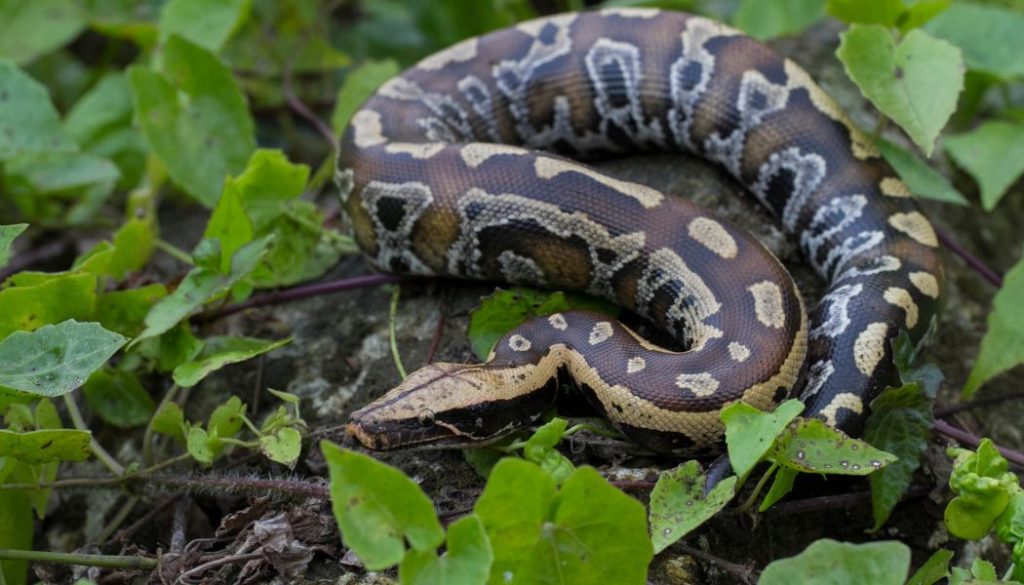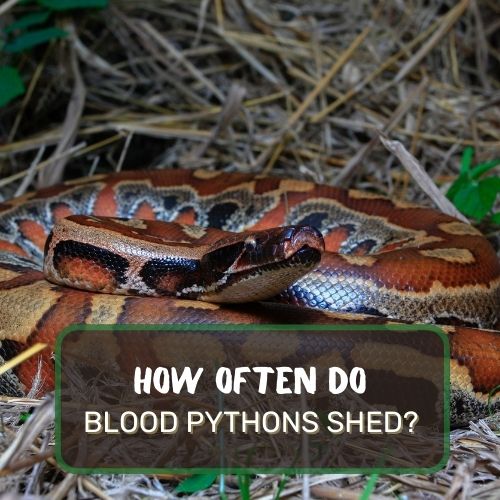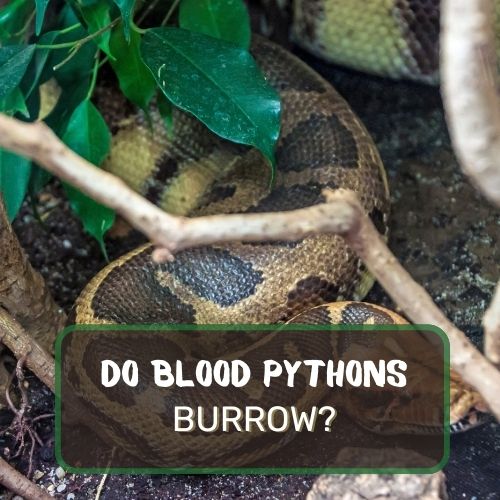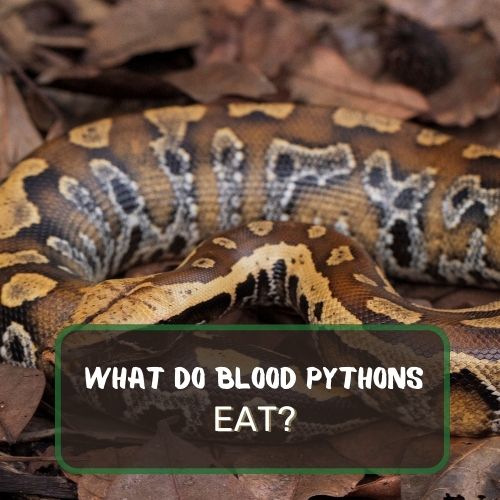Welcome to the intriguing world of Blood Pythons! This article delves into the essential aspects of feeding these captivating reptiles.
Blood pythons primarily eat small mammals like rodents. In captivity, they are often fed pre-killed or frozen-thawed rats and mice, adjusted in size according to the python’s age and growth. This diet replicates their natural prey choices and ensures their health and well-being.
We’ll explore their diet, contrasting their wild habits with those in captivity, and the nuances of choosing between live, pre-killed, and frozen-thawed prey.
Additionally, we’ll guide you through tailored feeding schedules for hatchlings, juveniles, and adults, emphasizing the importance of adjusting meal frequency and size as your python grows.
We also tackle health concerns related to feeding and wrap up with a handy FAQ section.
Whether you’re a seasoned keeper or a curious enthusiast, this guide offers valuable insights into the dietary needs and care of Blood Pythons.

Table of Contents
- 1 The Diet of Blood Pythons: Wild vs Captivity
- 2 Live vs. Pre-Killed vs. Frozen-Thawed Prey
- 3 Feeding Schedules for Hatchlings, Juveniles, and Adults
- 4 Adjusting the Frequency of Meals Based on the Snake’s Age and Size
- 5 Adjusting Prey Size Based on the Python’s Age and Size
- 6 Health Concerns Related to Feeding
- 7 Final Take
- 8 FAQ
The Diet of Blood Pythons: Wild vs Captivity
Diving into the fascinating diet of blood pythons, we find a stark contrast between their wild and captive lifestyles. In the wild, blood pythons, with their nocturnal ambush tactics, feast primarily on small mammals and occasionally birds, exploiting the dense jungles and marshlands of Southeast Asia.
Picture this: a stealthy python, coiled and ready, striking with precision as an unsuspecting rodent scurries by. This is the raw, instinctive world of the blood python in its natural habitat.
Transitioning to captivity, the menu changes. The responsibility falls on us, the caretakers, to replicate a diet that maintains their health and vitality. In captivity, blood pythons are typically fed rodents, but the type, size, and frequency of these meals vary, and it’s crucial to strike a balance.
Overfeeding can lead to obesity, a common problem in captive blood pythons due to their slower metabolism compared to their wild counterparts. Understanding this, we aim for a diet that keeps them lean and healthy, mirroring their natural feeding rhythms as closely as possible.
Live vs. Pre-Killed vs. Frozen-Thawed Prey
Now, let’s delve into the debate of live vs. pre-killed vs. frozen-thawed prey. Each option has its pros and cons, and understanding them is key to making informed decisions for your slithery friend.
Starting with live prey, the most natural choice, it offers a stimulating experience for the python. However, it’s not without risks. Live rodents can injure the python, leading to wounds or infections. It’s a bit of a wild card – exciting, yes, but potentially dangerous.
Switching gears to pre-killed and frozen-thawed prey, these are the safer bets. They eliminate the risk of injury to the python and are more convenient for the keeper.
With frozen-thawed, there’s an added benefit of long-term storage, ensuring a steady supply of food. However, the challenge lies in making these meals appealing – they lack the movement and warmth of live prey.
This is where your skills as a python chef come into play. Warming up the prey to the right temperature can make a world of difference, enticing your python to eat as if it were catching live prey.
Each feeding method has its place, and often, it’s about understanding your python’s preferences and adapting accordingly. Remember, what works for one may not work for another – the key is observation, adaptation, and a bit of patience.
Feeding Schedules for Hatchlings, Juveniles, and Adults
When it comes to blood pythons, their age plays a pivotal role in determining their feeding schedule. For the tiny, yet voracious hatchlings, think of a weekly feast.
Imagine these younglings, barely out of their eggs, tackling small rodents like pinkies or fuzzies with surprising gusto. It’s a critical time for growth, and this frequent dining ensures they get all the nutrients they need to flourish.
As they mature into juveniles, their appetite doesn’t wane, but their meal size increases. They still dine weekly, but now they’re onto bigger prey like weaned rats. It’s like watching a teenager outgrow their clothes – these juveniles are growing fast and need the extra fuel to keep up with their rapid development.
Adult blood pythons, majestic and full-grown, are the epitome of the saying ‘less is more’. They shift to a bi-weekly feeding schedule, indulging in larger rats. It’s fascinating to see their metabolism in action – slower, yet efficient, making every meal count.
This change in frequency is crucial to prevent obesity, ensuring they remain healthy and agile.
Adjusting the Frequency of Meals Based on the Snake’s Age and Size
The art of feeding blood pythons is akin to a balancing act – it’s all about tailoring the meal frequency to the snake’s age and size. As these creatures grow, their dietary needs evolve, and so must our approach to feeding them.
For the young and rapidly growing, a more frequent feeding schedule is essential. Weekly meals support their growth spurts, much like fueling up a high-performance engine.
But as they reach adulthood, their metabolic needs take a turn. It’s time to dial back the frequency to every two weeks, giving them enough to sustain their health without tipping the scales towards obesity.
And then, there’s the aspect of meal size – a crucial factor that goes hand in hand with frequency. Younger pythons thrive on smaller prey, but as they grow, so does their appetite for larger meals. It’s a delicate dance of increasing the prey size in tandem with their growth, ensuring each meal leaves a noticeable, yet not excessive, bulge.
Remember, each python is unique. Some might need slight adjustments in their feeding schedules, a testament to the individualized care these magnificent creatures require. Observing your python’s behavior, weight, and overall health is key to nailing down that perfect feeding rhythm.
Adjusting Prey Size Based on the Python’s Age and Size
When it comes to feeding blood pythons, one size does not fit all – literally. As a python grows from a curious hatchling to a majestic adult, its dietary needs evolve dramatically.
The prey size must parallel this growth trajectory to ensure optimal health and well-being.
For the young blood pythons, small is the way to go. Start them off with petite prey like pinkies or fuzzies, which are easy for them to manage and digest. As they shed their skin and inch towards adulthood, their prey should grow with them.
Juveniles graduate to more substantial meals – think weaned or small rats. It’s like upgrading from a snack to a full-course meal, providing them with the necessary nutrients for their developmental stage.
As adults, blood pythons demand prey that matches their robust size. Large rats become the norm, offering a hearty meal that satisfies their slower metabolism without causing obesity.
The goal is to observe a noticeable bulge post-meal, a sign of a well-fed python, without pushing them into the realm of overfeeding.
In essence, as your python grows, so should the size of its prey – a critical aspect of their care that ensures a happy, healthy life.
Health Concerns Related to Feeding
Feeding blood pythons is more than just a routine; it’s a crucial component of their care that, if mishandled, can lead to serious health concerns. Overfeeding is a prime culprit, often leading to obesity in these less active reptiles.
An overweight blood python is a sad sight, prone to a myriad of health issues, from difficulty in shedding to a higher risk of heart and liver diseases. It’s like us eating fast food every day – convenient but far from healthy.
Then there’s the risk of underfeeding, although less common, it’s equally perilous. An underfed python is a weak python, vulnerable to infections and lacking the energy to thrive. It’s akin to skipping meals regularly, leaving you drained and unwell.
Another crucial aspect is the type of prey offered. Feeding live prey, while natural, can lead to injuries from defensive bites or scratches from the prey. Imagine a tiny rodent turning the tables and harming your python – it’s rare, but it happens.
Frozen-thawed or pre-killed options are safer, though they come with their own set of challenges, like ensuring the prey is properly thawed to avoid digestive issues.
Lastly, nutritional imbalance is a concern. Just like humans can’t live on bread alone, pythons need a varied diet to meet their nutritional needs. Feeding them the same type of rodent repeatedly can lead to deficiencies or excesses in certain nutrients.
Final Take
As you’ve learned, feeding blood pythons correctly is crucial for their health. Remember, balance their diet with appropriate prey, considering their age and size. Adjust feeding frequency as they grow and always prioritize their well-being.
With the knowledge you’ve gained, you’re well-equipped to provide excellent care for these fascinating creatures.
Embrace the journey of nurturing your blood python, ensuring a fulfilling experience for both you and your scaly companion.
Keep exploring and learning – your dedication makes all the difference in their lives!
FAQ
What do you feed blood pythons?
Blood pythons primarily dine on rodents, such as mice and rats. In captivity, they can be fed pre-killed or frozen-thawed rodents, which are safer and more practical than live prey. The key is to choose the right size – small prey for hatchlings and progressively larger ones as they grow. It’s like selecting the right portion size for a growing child, ensuring they get just what they need for healthy development.
Do blood pythons like water?
Absolutely! Blood pythons, like many other snake species, appreciate having access to water. A large, sturdy water bowl in their enclosure is not just for drinking; they often enjoy soaking in it too. This soaking can be especially beneficial during shedding periods. Think of it as their own little spa – a place for hydration, relaxation, and aiding in their natural processes.
What do blood pythons eat in the wild?
In their natural habitat, blood pythons are ambush predators, primarily feeding on small mammals and occasionally birds. They use their stealth and strength to capture prey such as rodents, leveraging their environment in the dense forests and marshlands of Southeast Asia. It’s a game of patience and precision in the wild, quite different from their predictable meals in captivity.
How much should you feed a Blood python?
The feeding amount depends on the python’s age and size. Hatchlings and juveniles should be fed once a week, transitioning to every two weeks as adults. Adult blood pythons typically eat a large rat bi-weekly. It’s important to observe the python’s body condition and adjust as needed – a slight bulge post-feeding is a good sign, but anything more might indicate overfeeding. Think of it as finding the right balance between satisfying their appetite and maintaining their health.




0 Comments